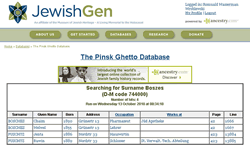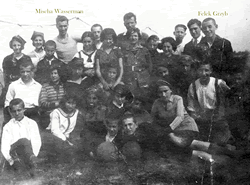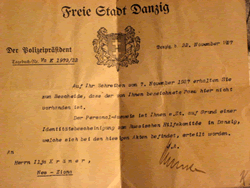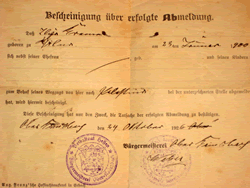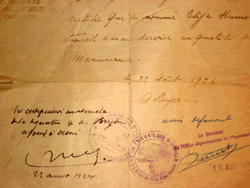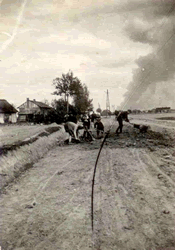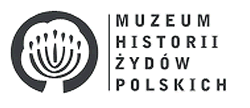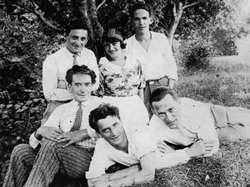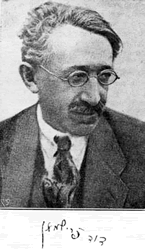Eva was the mother of Joshua, Rivka and Dvora. The family name, to the best of my
knowledge, should be written as "BIBELAJZER". The name of Eva's husband was
Mordechi. He died prior to the WW2.
Bibilaizer Eva, Warsaw/Warszawa Poland 1868
Bibilaizer Rivka Born: Warsaw/Warszawa Poland 1905
Bibilaizer Joszua Born: Warsaw/Warszawa Poland 1909
Bibilaizer Dvora Born: Warsaw/Warszawa Poland 1907
Many many thanks for any information,
Henry Grandicki
My father's sister, (Sala) was married to a man named Avraham Lewitan. He was
born in Warsaw, Poland.
Avraham's father, named Yeshayahu was born in Siaului, Lithuania (if I'm not
mistaken) and settled in Warsaw. Avraham is the only member of the family,to
have survived(he survived the Warsaw ghetto uprising together with his wife and
daughter, only to be caught in a burning building (Aprill 1943), to be sent to
Treblinka(he survived this camp and several others) this is how we know who and
how they perished. Avraham had a sister who emigrated to Israel(early 1930's),
and they were in the construction business. Avraham settled in Eretz Yisrael
after the war and remarried.
Would Avraham Lewitan be any relation?
He passed away only a couple of years ago. I recently was told this story and
I'm sorry I never met him.
Geri Levine (geri@levinecorp.com)
that the speaker at the JRI-Poland luncheon on opening day
of the conference (Sunday, August 17) will be a representative
of the Museum of the History of Polish Jews in Warsaw.
Nearly 80 percent of the world's Jews can trace their roots to
Poland where Jewish presence predates the Holocaust by
almost 1000 years. Now, the Museum of the History of Polish
Jews, a center for education and culture, dedicated to
preserving the lasting legacy of Jewish life in Poland is to be
opened in Warsaw in 2011.
Located in what was the heart of the Warsaw Jewish Quarter
and opposite the Monument to the Heroes of the Warsaw
Ghetto Uprising, the Museum, using the latest research and
innovative exhibition design will immerse visitors in the world
of Polish Jews end encourage exploration through a wide
range of media, documents and artifacts.
The Museum's representative will present the plans of the
eight core exhibition galleries which trace Jewish history in
Poland from 966 A.D. until the present, and discuss the
initiatives undertaken by Jewish communities around the
world to support the Museum.
Don't miss what will be a most interesting presentation.
Sign up on the conference website to attend the luncheon.
If you have already registered for the conference, you
can add the JRI-Poland luncheon to your registration.
Stanley Diamond
Executive Director
On behalf of The Board of Jewish Records Indexing - Poland
BLUMENSON of Widoma ("Yekl Widomer"), had a wealthy brother living
Warsaw in the mid 1860's. The information is gleaned from a personal
letter of his seemingly written to this brother.
The only leads I have are that Jankel was originally from Piotrkow
(b. 1795) , but moved to the Przedborz area to marry and enhance his
rabbinic studies. An internet source about Jews of Warsaw says that
there were indeed two wealthy Jews living there and originally from
Piotrkow. Their names were Josel Jankel and Szmul, and they lived
slightly before the era of surnames (around 1800). I thought there
might be a connection, though if they were "my" Jankel's relatives,
they'd be significantly older (and possibly no longer living by the
1860's).
I'd appreciate it if someone who has information regarding wealthy
Jews of Warsaw from 19th century could contact me, or also contact me
if you have specific information about the Josel Jankel and Szmul
mentioned above.
I know its a long shot...
Thank you.
Steve Bloom
From: Steven Lasky
This evening the searchable database of approximately 88,000 burials went
online for Mt. Lebanon Cemetery in Glendale, Queens, New York. I am assuming
that this is not a test and will still be online tomorrow morning, but you
never know. Whichever the case, it is ready (or nearly so) for you to use.
There are more than 260 society plots within this cemetery. On the cemetery
website, just click on the link at the top of the page that says "Interment
Search/Genealogy" and search away.
On the website main page is a link to the Cemetery Grounds Map.
The searchable fields are First Name, Last Name, Date of Death (Month/Year),
Block, Reference, and Society (Name.)
Just did a couple of initial tries, and the fields seem to be working
properly.
As to Block and Reference, Block is the block number or letter as it appears
on the Cemetery Grounds Map. Reference refers to the gate number. You can
also use the searchable JGSNY database to determine the Block and Reference
(Gate) number and use those numbers and letters if you wish. This can be
found at www.jgsny.org/searchcity.htm.
As to the Society (Name) field, I would suggest that before using this
search field, you click on the "About Us" link at the top of each page,
scroll down to the link for "societies/organiations/synagogues," click on
it, then look for the society of interest to you. I might suggest for now
that you use the "commonly used name" first in the Society field, and if
that doesn't work, just chose a keyword from this "commonly used name,"
preferably the word that signifies, e.g., the town that the plot is
associated with.
The best enhanced feature it seems is that this database at least (not the
other five created so far) dispalys a maximum of 500 search results, much
more than the 200 the other five databases give you.
That's pretty good! I have no idea whether they will expand the other
databases so they display 500 search results or not.
The Mt. Lebanon Cemetery website and searchable database can be found at
www.mountlebanoncemetery.com.
If you notice any particular problems with this database, i.e. functional
problems, and not that you can't find a name, there is a spelling or data
entry mistake, please let me know and I will let them know.
So far, the database looks good.
This is the sixth NYC Queens cemetery database that is now online, and I
believe that combined these databases allow us to search among 630,000
records!
Still to come, perhaps in the next few months, will be Knollwood Park
Cemetery, which now is supervised by the folks at nearby Mt. Carmel
Cemetery. You will be able to find these records on the Mt. Carmel Cemetery
website once it is uploaded, though it could be, as I've said, a few months
or so.
Glad I could be the bearer of good tidings!
L'Shana Tova,
Steven Lasky
New York
----------------------------------------------------------------------
The traditional Jewish section of Warsaw was located in the southwest
central part of the City, particularly around Muranow, Powazki, Leszno, and
Grzybowski square - It was considered the largest Yiddish-speaking center in
Europe. A good book to read to give you a feel for Warsaw during this time
would be: Warsaw Between the World Wars: Profile of the Capital City in a
Developing Land, 1918 - 1939 by Edward D. Wynot, Jr., published in 1983,
ISBN 0-88033-018-X
George Mason
----- Original Message -----
From: "Jordan Magill" <jamagill@pacbell.net>
I am looking for any information anyone can offer on the neighborhood of
Leszno street circa 1920-38. Any information (soci-economic, cultural,
commercial, etc) would be greatly appreciated.
http://www.jewishgen.org/JewishGen/ValueAdded.asp
--
You are currently subscribed to warszawa as: [gmason3815@sbcglobal.net]
To change the format of our mailings, to stop/resume delivery (vacation),
or to unsubscribe, please go to http://www.jewishgen.org/listserv
---
END OF DIGEST
~~~~~~~~~~~~~~~~~~~~~~~~~~~~~~~~~~~~~~~~~~~~~~~~~~~~~~~~~~~~~~~~~~~~~~
This Research Group (warszawa@lyris.jewishgen.org) is hosted by
JewishGen: The Home of Jewish Genealogy
Visit our home page at http://www.jewishgen.org
Sign up now for value-added services!
http://www.jewishgen.org/JewishGen/ValueAdded.asp
--
You are currently subscribed to warszawa as: [eilat.gordinlevitan@gmail.com]
To change the format of our mailings, to stop/resume delivery (vacation),
or to unsubscribe, please go to http://www.jewishgen.org/listserv
I am searching information about my mother's family history and need some help.
My mother's maternal grandpearents were Nechuma-Szejna Morlender (born 1884 in siedlce, died 1926 in Warsawa) and Boruch-Lejb Galperyn/Halperin. they were Married in 1902 in Siedlce and had 3 children:
1. Yehoshua Halperin (born 1903 in warsaw, died 1965 in Tel Aviv, Israel) married Rochel Begin (sister of late israeli PM Menahem Begin) and were parents of Ari (Born Warsawa 1938 - Died 1942 in Brest Ghetto, Belarus) and Emanuel (Born 1943 in Toshkent, Uzbekistan).
2. Yehudit/Judita (born April 4th 1904 in Warsawa, died February 1973 in Jerusalem, Israel) before WW2 she was an athlete and married Arno Erb, who died during the war. she married Asher Gil (Gilipter) after immigrating to Israel.
3. My grandmother: Lija ( Lea, or Lola) Halperin (born June 10th 1909 in Warsawa, died December 20th 1951 in Raanana, Israel). Lola was married on September 8th 1935 in Jerusalem to my grandfather Bronislaw Sztraubaum who changed his name to Dov Tibbon (Born July 1st 1907 in Warsawa, died March 23rd 1972 in Jerusalem) . They had 2 children: Ari Tibbon and Nava-Meira.
Rochel nee Begin (at an old age) recalled:
1. Boruch-Leijb Halperyn had a brother named Chaim and sisters named Brunia, Frenia & Ester (who's married name was Weinsztock and had a son Lolek and a daughter Reginka). another brother or sister of Boruch-Lejb's had a son Tadeusz and a daughter Sala.
2. Boruch-Lejb Galperyn was somehow a relative (cousin or brother-in-law, we think) of an Aharon Goldberg from Pinsk, Belarus (son of Nachum & Mirlya Alta Goldberg, father of Natan, Avraham & Gunia) who was given custody of Lola and her brother and sister when their pearents died).
3. in 1916, during the battle on Verdan in WW1, Yehoshua Halperin was in France studying french with a female relative of his who's last name was Farber. we have no idea who she was or how they were related.
4. Nechuma-Szejna Morlender's father died when she was young and her widowed mother married a widow named either Eliahu or Szmuel Barg. mr. Barg had a daughter called Frejda Lipshitz (born 1877 in siedlce -
died 1962 in Jerusalem, Israel) and MAYBE a set of twins called Gersz Wulf and Dawid from his first wife, and with Nuchuma-Szejna's mother he had twins and MAYBE a dauhter named Helena.
5. Nechuma-Szejna Morlender is believed to be a grand daughter of Chaim Boruch Izrael MUHRENLANDER (1819-1890), chief Rabbi of Warsawa and author of "birkat Chaim" book, and a decendant of the REMA (Rabbi
Moses Isserles)
On her Paternal side My mother's grandpearents were Meir Sztraubaun & Rozelia-Rachel Himelfarb (died August 22nd 1966 in Warsawa). they had 7 children:
1. Stanislaw Yshayahu (Stach) - changed his last name to Olecki, married Dora Biderman and had a son Sevek (Simcha) Tibbon and a Daughter Zula (Shoshana) Reich.
2. my grandfather Bronislaw Sztraubaum/ Dov Tibbon
3. Anna sztraubaum (born Dec. 24th 1912 Warsawa, died May 19th 1990 in Warsawa).
4. Helena (Hella) Sztraubaum (died Dec. 20th 1968 in Warsawa).
5. Alexander (Olek) - changed his last name to Olecki, married Irena (Irka) Berman (sister of communists Adolf & Jakub Berman) and had 2 daughters: Ania & Gusha.
6. Balla Szpyzman-Pavlovski, married Pinchas-Pyoter Szpyzman-Pavlovski and had 1 son: Ludvig "Bogush" elieazer Pavlovski (26.12.1938-21.7.1991)
7. Paula Kolek (1917-1940) was married to a man who turned her to the Nazis.
we know nothing else about the Sztraubaum - himelfarb families and cant seem to find Ania & Gusha Olecki.
if any of you finds anything familiar or just knows better where to search for other information I would be so greatful...
Thanx in advance,
Mattan Segev,
Jerusalem, Israel.
By DPA
Poland's capital on Wednesday marked the completion of a massive
restoration project that marks the borders of the former Jewish Ghetto
that was walled in by Nazis occupiers during World War II.
The mayor of Warsaw, along with the minister of culture, inaugurated
the project that included 21 new information points along the
boundaries of the former Jewish Ghetto. The project also placed a
beige line, labeled "Ghetto Wall," along the city streets that
outlined the furthest reaches of the Ghetto's borders.
The line snakes along sidewalks and around apartments and offices,
broken only when it reaches roads or tram lines.
Advertisement
Paid for by the city of Warsaw and the Ministry of Culture, the
project was launched last year by a team of historians.
"When you ask people in Warsaw about the Ghetto, they can tell you
about it and have an idea of where it was," said Tomasz Merta of the
Ministry of Culture. "But in reality, nobody could tell you how big it
was and how it was a huge prison in the heart of the city."
Varsovians can now easily find the line running along several major
streets near downtown and curling around what is now the Jewish
Cemetery.
"Now it's here, and we can see it and touch it. And it's very
difficult to remember, because of how hurtful it was," Merta said,
"but at least now we can remember. This is our responsibility."
Nazi officials cut off the Jewish Ghetto from the rest of the city on
November 16, 1940. At its broadest circumference, the Ghetto wall
enclosed 307 hectares.
Some 360,000 Warsaw Jews and 90,000 from other towns were forced into
the ghetto, according to the city of Warsaw. Some 100,000 people died
of hunger.
"It's not only important to Warsaw, but it's a universal lesson about
memory," Merta said.
The inauguration ceremony included a bus tour that took people along
the former borders and stopped at the information points that marked
important sites or events in the Ghetto's history.
A crowd of project officials, local residents and historians went
along for the trip. Older residents recalled the disquiet in the city
when the wall was first built.
"Nobody was sure if their house would lay in the Ghetto, or where the
borders would be," said historian Jan Jagielski, author of a book
about the Ghetto. "Walls had been built earlier, and people were
worried that there would be a ghetto. From November 16, people
couldn't leave."
Jagielski lead a group of mostly elderly women through a park and
wondered at how modern Warsaw sits atop borders that are gone but not
forgotten.
"This is all real and unreal," he said. "That we're here walking,
through these streets."
I have been searching for info. on my Mother's family;
Yudovich. My Mothers name was Chana, born in David Gorodok, Russia
March 18, 1899. Her Fathers name was Usher, or Asher Yudovich.Both He
and my Grandmother had approx:4 Boys and 5 daughters. My Grandfather
was known as "Usher the Perevozchic" He owned 2 Cargo and 3 Passenger
Ships, in addition to his own home in David Horodok.
My Mother, Chana, married my father Yosel Turkienicz, or
Turkenicz. His Father was Abraham. After marriage in David Horodok,or
David Grodak March 12, 1919 or I believe the Jewish calendar was Feb,
14, 1919 They then left to my Fathers home town of Stolin (nearby)
till approx: April or May 1921, when they left for America. They got
off the ship in Warsaw, Poland for my mother to give birth to my
brother Yankel (Jack) They proceeded to go to Odvok for the birth and
then after a short time, again left for America on the ship SS
Mauretania, arriving in New York City via London England June 12,
1921. Witnessing my parents wedding in David Grodak was Rabbi Zev Wolf
Ginzufin and Sh'maryah Lansky. Cantor and Shochet and Bodek.
Please be kind enough to supply me with any info. on my family
and their possessions, and whatever you know.
Looking forward to a early response and thanking you in advance,
Respectfully
Leonard Turken
I wonder if You know about the fate of Ryfka Boszes. She was working at Korczak Orphanage Bursa when studying medicine. Afterwards when MD she took care of Orphanage children.
Ryfka Boshes was from Pinsk. Her father, like my grandfather Boruch Wasserman were both teachers in Jewish School in Pinsk. Both were registered in Pinsk ghetto.
Roman Wasserman Wroblewski
son of Mischa at the attached picture.
I believe Photo WRSW OS-31 is a view of the famous Nalewki Street, noted for the number of Jewish establishments.
Thank you!
Isabel Cymerman
Roxbury, CT
isabelcym@aol.com
From: Tim Bertram <tim.bertram@vodafone.co.nz>
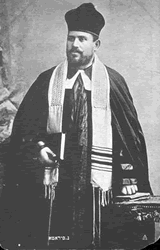
Dear Pan Eilat
Which shul is Warsaw #99, the Nozyk or Tolamackie please?
Does your collection of unlisted photos include any photos of Hazan Gershon Sirota?
Tim
Tim Bertram
Whangarei:
29 Lovatt Crescent, Mairtown, Whangarei 0112, New Zealand
phone 64 9 459 4424 | mobile 64 21 277 7876
Gershon-Itskhok Sirota (1874-1943) was one of the leading cantors of Europe during the "Golden Age of Hazzanut" (cantorial music), sometimes referred to as the "Jewish Caruso."
Sirota began his cantorial career in Odessa, then spent eight years in Vilna as cantor of the Shtatshul (State Synagogue) there. It was in Vilna that he began his collaboration with choirmaster Leo Lowe, which would continue throughout his career. He performed on numerous occasions throughout Europe, and in 1902 he sang at a reception in honor of Theodore Herzl, the founder of the Zionist Movement.
In 1907, Sirota assumed the position of cantor at the presigious Tlomackie Street Synagogue in Warsaw. He continued his concert appearances around Europe, and even sang in Carnegie Hall in New York City to a sold out crowd. While cantor at the Tlomackie Synagogue, he also began recording his music. The first Jewish records, made in Vienna, Berlin, and St. Petersburg and spread across the whole Jewish world, were of the two famous khazonim: Gershon Sirota and Zanvil Kvartin. As the technology improved, he was constantly rerecording the songs, so that listeners can trace the improvement of his rich tenor voice over the years.
While Sirota eventually left the synagogue over disputes concerning his frequent performances, he continued to live in Warsaw. Nevertheless, he travelled frequently, and his concerts were attended by Jewish and Christian audiences alike--and according to some accounts, even by Caruso.
Caught in Warsaw during the Nazi invasion of Poland during World War II, he spent his final years living in the Warsaw Ghetto, and died in the Warsaw Ghetto Uprising in 1943
Perhaps you are interested in the attached JPG file of a photo in the possession of my family, depicting the smoke billowing from the Warsaw Ghetto uprising.
My mother (Ewa Toren nee Heller)
and grandmother were interred in the Warsaw ghetto during WWII. They suffered the hardships and the hunger, and an aunt and a cousin staying with them were killed during this time. Finally my mother and grandmother escaped to the Aryan side where they spent very difficult time in clandestine hiding.
Once on the outside from the Ghetto, they had contact with youngsters active in the Armia Krajowa resistance movement. These AK teenagers were not aware my mother and grandmother were Jewish. It occurred during the time when it was possible to see in the city, for weeks and weeks, the fires raging in the Jewish Ghetto. The AK youth told my mother they had made some snapshot pictures of the smoke billowing from the fires of the Jewish uprising. When they offered her one of the pictures, she was extremely glad to take it, though she was careful not to disclose her true interest in this. Incidentally, all of the teenagers in this group of AK later were killed in the later failed Polish uprising.
The photo was taken from a village outside of Warsaw. It is so far out in the countryside, the houses of the city are not even seen on the horizon. Peasants are seen peacefully tilling the field, while in the distant background, a pillar of smoke can be seen. It could be mistaken for a pastoral scene. Since the fields look fully harvested, this picture was probably taken during the end of the uprising, towards summer.
My grandmother inscribed the scene on the backside, shortly after the War, signing with her real name. During the years on the Christian side, she had assumed a fake identity.
Immediately after the end of the war, in Cracow were my mother and grandmother had returned to, Poles started looking for Jewish survivors to put to slave labor . Within a few weeks at first opportunity, my mother and grandmother decided to flee from these renewed atrocities. They resolved to immigrate to Palestine. They escaped to Romania but had to wait for passage on a ship to Palestine until 1947. They were apprehended at sea and detained in a concentration camp in Cyprus by the British in contravention to the Mandate of the League of Nations reserving Palestine as the homeland to the Jewish people.
Although immigrants had been advised not to bring documentation on board, my mother took the photo and eventually brought it to Israel when she was released from Cyprus in 1948. It has been with her ever since.
Best regards,
Ami Toren
my father, isaac graber, had a sistem, rachel graber, who was born in warsaw but, we believe was killed in warsaw. if you had more info, we would be grateful
Bruce Graeber
The Herrick Group LLC
The Cedarhurst Center
445 Central Avenue (Suite 210)
Cedarhurst, New York, 11516
From: benhard@mbiberica.es <benhard@mbiberica.es>
Date: Tue, Jul 31, 2012 at 5:58 AM
Subject: Frankfurt family
To: egl.comments@gmail.com
I'm searching the family of my great-mother, Dora Frankfurt. They lived in Warsaw Marszalkowska street n? 73 and they have a kefir industry in Twarda st. n1 13. I know nothing about them. One of her brothers Macsimilian Marek Frankfurt was a photograph and he worked on two famous polish films in 1947, please can you help me?
Many thanks,
victoria benhard
On Thu, Sep 27, 2012 at 5:14 AM, Jakub Krowicki <jkrowicki@jewishmuseum.org.pl> wrote:
Dear Sir or Madam,
I'm writing in behalf of Museum of the History of Polish Jews.
Museum of the History of Polish Jews goes on with its work to create a core
exhibition on the almost thousand years of the history of Polish Jewry. The
scheduled opening date is 2013. Although our narrative historic exhibit will be
multimedia-based and interactive, our intent is also to display certain original
objects as part of it.
Among others, we would like to present a reproduction of photography that can be found on your webpage:
http://www.eilatgordinlevitan.com/warsaw/w_pix/ghetto_fighters/071206_32w_b.gif
You will find the details in the attachment
Do you own the rights to that photography, or perhaps you know who owns them and where the original could be found.
Could you possibly provide us with a high quality scan i. e. a 300 dpi TIFF?
We would be sincerely grateful for your help.
Please inform us in advance about the possible reproduction fee.
Yours sincerely,
Jakub Krowicki
M?odszy Specjalista ds. Obiektów Cyfrowych i Oryginalnych
Artifactors & Digital Assets Junior Specialist
The Museum of the History of Polish Jews
ul. ?wi?tojerska 5/7, 00-236 Warszawa
t. +48 22 471 03 68, f.
jkrowicki@jewishmuseum.org.pl
www.jewishmuseum.org.pl
The picture of Adolf Berman is from the "Lohamei Hagetaot" site in Israel. You could find it online. I see many pictures of Adolf on other sites. I am sure that it is fine to use it. Let me know if you found a better quality scan. Are you also planing to have a picture of his brother Jacob? He must not have been liked in Poland.
Thanks,
Eilat
Purim reminds us it’s unusual for Jews to indulge in recreational boozing—one reason Polish nobles liked having them run taverns
When Polish writer Adam Mickiewicz needed a bar setting for his epic 1834 poem “Pan Tadeusz,” he named his tavernkeeper “Yankel” and described a watering hole that embodied its Jewish owner: “From a distance the rickety old tavern looked / like a Jew rocking in prayer / the roof like a hat, the thatch spilling down like a beard / the sooty walls like a gabardine / in front, carvings protruding like tzitzit down his body.”
Today it seems like a strange idea: Outside of the Nazarian nightclub-and-hotel empire and a few places in the East Village, what Jews own bars? But in early-19th-century Poland, approximately 85 percent of registered taverns were leased by Jews—and there was no shortage of taverns. For Poles of that time, there was a stereotypical image of a bartender, and he had a beard, a yarmulke and peyos. Jewish domination of Poland’s drinking culture was so complete and lasted so long that Poles simply assumed a connection between Jews and booze. As a standard Polish proverb of the time had it: “The peasant drinks at the inn, and the Jew does him in.”
Unlike most other aspects of the collective Jewish experience—in a tradition that commemorates events that happened 5,000 years ago as though they took place last year—almost all traces of this history have vanished from our group memory. Jews entered the field, dominated it in a region, and then left it almost as quickly as they found it. There’s nothing particularly boozy about Jewish economic history or culture, prior to or since this period in Poland. There are no Jewish cocktails and no spirits that are uniquely Jewish. There weren’t any major Jewish innovations in the industry, and the Jewish legacy left to the world of booze is essentially nil. Why?
Hello, I am writing to you in order to find out if you may have any information or evidence that may help me track the whereabouts of my late father Zugmunt Kulas during the war. He was born in Warsaw in 1936.
From the information we have his mother was killed, he was moving between hiding places (names as Matys or Aleksandra Berlowicz, or W?odzimierz Janczewski may be relevant to the people hiding him or with him).
In addition he was kept by the organization Franciscan sisters of family of Mary.
Any information that you may have will be highly appreciated.
Thank you in advance,
Yaron Kulas
Israel
Icok Kulas was born in Radzymin, Poland in 1912 to Benjamin and Roza. He was married Riwka. Prior to WWII he lived in Warszawa, Poland. During the war he was in Warszawa, Poland.
Icok was murdered in the Shoah.
This information is based on a Page of Testimony (displayed on left) submitted by his brother Daniel david Kulas Geist. .
Riwka Kulas nee Rotshtein was born in Warszawa, Poland in 1908 to Shymon. She was married Icok. Prior to WWII she lived in Warszawa, Poland. During the war she was in Warszawa, Poland.
Riwka was murdered in the Shoah.
This information is based on a Page of Testimony (displayed on left) submitted by her brother-in-law Daniel david Kulas Geist..
Chana Kulas was born in Radzymin, Poland in 1924 to Benjamin and Roza. Prior to WWII she lived in Radzymin, Poland. During the war she was in Slutsk, Belorussia (USSR).
Chana was murdered in the Shoah.
This information is based on a Page of Testimony (displayed on left) submitted by her brother
Benjamin Kulas was born in Radzymin, Poland in 1893 to Dawid and Perel. He was married Fruma Chaja Burstein. Prior to WWII he lived in Radzymin, Poland. During the war he was in Slutsk, Belorussia (USSR).
Benjamin was murdered in the Shoah.
This information is based on a Page of Testimony (displayed on left) submitted by his son.
Chaja Rosa Kulas nee Burshtin was born in Radzymin, Poland in 1891 to Yehuda and Lea. She was married Benjamin. Prior to WWII she lived in Radzymin, Poland. During the war she was in Slutsk, Belorussia (USSR).
Chaja was murdered in the Shoah.
This information is based on a Page of Testimony (displayed on left) submitted by her son.
Shepsel Kulas was born in Radzymin, Poland in 1926 to Benjamin and Roza. He was a child. Prior to WWII he lived in Radzymin, Poland. During the war he was in Slutsk, Belorussia (USSR).
Shepsel was murdered in the Shoah.
This information is based on a Page of Testimony (displayed on left) submitted by his brother.
-------------------
Rachel Kulas nee Kronenvald was born in Warszawa, Poland to Berl and Gitel. She was married. Prior to WWII she lived in Warszawa, Poland. During the war she was in Warszawa, Poland.
Rachel was murdered in the Shoah.
This information is based on a Page of Testimony (displayed on left) submitted by her brother Jack
...............................
Tanhum Kulas was born in Nasielsk, Poland in 1873. He was a merchant and married Gitel. Prior to WWII he lived in Nasielsk, Poland. During the war he was in Nasielsk, Poland.
Tanhum was murdered in the Shoah.
This information is based on a Page of Testimony (displayed on left) submitted by his granddaughter Erlichman Chaia Dina
Gitel Kulas was born in Nasielsk, Poland in 1867. She was a housewife and married Tankhum. Prior to WWII she lived in Nasielsk, Poland. During the war she was in Nasielsk, Poland.
Gitel was murdered in the Shoah.
This information is based on a Page of Testimony (displayed on left) submitted by her relative.
-----------
---Rywka Kulas was born in Warszawa, Poland in 1904 to Berl and Gitel. She was a merchant and married. Prior to WWII she lived in Warszawa, Poland. During the war she was in Warszawa, Poland.
Rywka was murdered in the Shoah.
This information is based on a Page of Testimony (displayed on left) submitted by her aunt, a Shoah survivor. ---------
Perl Kulas was born in Nasielsk, Poland in 1880 to Berl and Charna. She was a housewife and married Yisrael. Prior to WWII she lived in Nasielsk, Poland. During the war she was in Nasielsk, Poland.
Perl was murdered in the Shoah.
This information is based on a Page of Testimony (displayed on left) submitted by her relative.
Israel Kulas was born in Nasielsk, Poland in 1880. He was a butcher and married Perel. Prior to WWII he lived in Nasielsk, Poland. During the war he was in Nasielsk, Poland.
Israel was murdered in the Shoah.
This information is based on a Page of Testimony (displayed on left) submitted by his relative.
Tanchum Kulas was born in Nasielsk, Poland in 1913 to Yisrael and Perel. He was a merchant and single. Prior to WWII he lived in Nasielsk, Poland. During the war he was in Poltusk, Poland.
Tanchum was murdered in the Shoah.
This information is based on a Page of Testimony (displayed on left) submitted by his relative.
'''''''''''''''''''''''''''
Dwora Kulas was born in Makow Mazowiecki, Poland in 1894. She was a housewife and married Khishel. Prior to WWII she lived in Makow Mazowiecki, Poland. During the war she was in Makow Mazowiecki, Poland.
Dwora was murdered in the Shoah.
This information is based on a Page of Testimony (displayed on left) submitted by her neighbor.
Abraham Kulas was born in Pabianice, Poland in 1885. Prior to WWII he lived in Pabianice, Poland.
Abraham was murdered in the Shoah.
This information is based on a Page of Testimony (displayed on left) submitted by his cousin.
I am looking for information about the children of Hillel Brumberg who lived in 31 Dezlana Street in Warsaw. Hillel passed away on October 13, 1926. His wife Esther, his son, daughters, grandson and granddaughter
all perished most likely in 1942 in Triblanka.Hillel was the brother of my grandmother Feygel who passed away in 1918 in the town Tlichan (my parents were born there)
hanoch benayahu <randan22@012.net.i.>
Abram Brumberg was born in Poland to Hilel. He was married Malka. Prior to WWII he lived in Swenziany, Poland. During the war he was in Swenziany, Poland.
Abram was murdered in the Shoah.
This information is based on a Page of Testimony (displayed on left) submitted by his granddaughter.
Aron Brumberg was born in Kimeliszki, Poland in 1927 to Shimon and Ester. Prior to WWII he lived in Kimeliszki, Poland. During the war he was in Kimeliszki, Poland.
Aron was murdered in the Shoah.
This information is based on a Page of Testimony (displayed on left) submitted by his cousin.
Hello,
I am researching the life of Yitzhak Kaplan, great grandfather of my husband.
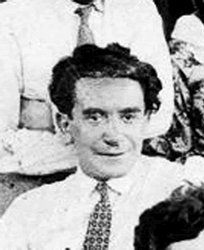
He had a very active career, travelled the world following the Yiddish Theaters all over the world.
I know that he lived for a short period in Warsaw Poland, and even met his young wife Pessia there.
His life and life of his family was like an adventure book. I can not even discrube it to you in one letter.
I am constantly looking for his pictures and any information about his family.
Here is his "resume" from the Museum of Family History:
http://www.museumoffamilyhistory.com/yt/lex/K/kaplan-yitzhak.htm
The picture on your site made me jump, I really think it is him.
I have copied it and posted it on Facebook for my family to see ( I hope I have not made you upset that I have saved the image.... And shared it...)
But when I post it there it tags him automatically as my father in law!!
I am hoping to learn more about this picture.
Thank you so much,
Maria S. Farber
Sent from my iPhone
On Jan 16, 2015, at 5:37 PM, eilat gordin <egl.comments@gmail.com> wrote:
-
From: <mariasinfarber@yahoo.com>
Hello,
Thank you so much for creating your website. It is truly a wonderful museum.
I wanted to inquire about the attached photograph I have found on your Warsaw Poland page.
What was the source of this picture? What year was it taken?
And do you know who is photographed? I have singled out one man who is of interest to me. Is that Yitzhak Kaplan?
Thank you,
Maria S. Farber
The source could be found at http://www.gfh.org.il/eng/
Brief Description: Jewish theater actors in Warsaw.
Catalog No.: 37526
Type of Item: Photo
Databank: Photo Archive
Jewish theater actors in Warsaw. Photographed between the two world wars.
<ansbachr@netvision.net.il>
Date: 2015-07-06 14:37 GMT-07:00
Subject: Helena Lejman nee Fiszhaut
To: egl.comments@gmail.com

Elisheva Ansbacher, Advocate
16A King George St.
9422916 Jerusalem Israel
tel: +972-2-6250410
fax: + 972-2-6232126
email: ansbachr@netvision.net.il
In commemoration of the start of the Warszawa Ghetto Uprising on the Eve of Passover, April 19, 1943, Jewish Records Indexing-Poland has added nearly 5,600 more Warszawa vital records to the JRI-Poland database.
Jewish Records of Poland, http://jri-poland.org/
Updates were made to the following projects:
1) Additional extracts for the Warszawa LDS Jewish data covering the 1826-1865 time period (Fond 180). This dataset now consists of over
70,000 records. We have begun to add image links to this file and the first film that was linked is LDS microfilm 069531
2) Additional extracts for the Warszawa Jewish records from Fond 200 covering the 1864-1915 time period. This group of files contains over
83,000 records of which 83% are now image linked.
Our researchers are working on the data extracts and filling in the gaps on what has not been done. Each successive year another year becomes available for indexing. Though many of the records were destroyed or disappeared during the decimation of the city during World War II, we still have many more records to extract.
David Frischmann
Russian Hebraist; born in Lodz 1863; now (1903) residing in Warsaw. Frischman began very early to write both poetry and prose in Hebrew periodicals, and his style and the originality of his views soon attracted attention. He was assistant editor of "Ha-Yom," in St. Petersburg (1886-87), and afterward editor of the weekly "Ha-Dor." Frischman has contributed a large number of poems, short stories, and articles to the Hebrew periodicals during the last twenty years. His earlier writings are to be found in "Ha-Bo?er Or," "Ha-Sha?ar," "Ha-Asif," etc. His works include: the short story "Be-Yom ha-Kippurim," Warsaw, 1881; his successful translation of Aaron Bernstein's "Aus dem Reiche der Natur," under the title "Yedi'ot ha-?eva'" (The Perceptions of Nature) (1882-85); "Tohu wo-Bohu," a scathing criticism of Hebrew journalistic methods, especially directed against "Ha-Meli?," with an appendix, "'Al ha-Nes," in which I. L. Lewin's translation of Disraeli's "Tancred" is severely criticized (ib. 1883); "Miktavim 'al Devar ha-Sifrut" (Notes on the History of Literature), a criticism against contemporary Hebrew literature (Warsaw, 1895). He also translated Julius Lippert's "Kulturgeschichte," under the title "Toledot Hashlamat ha-Adam," in three parts (ib. 1894-1901). A collection of his scattered articles and feuilletons is at present (1903) being published in Warsaw under the title "Ketavim Niv?arim." Frischman has also written considerably for Yiddish periodicals. The poem "Ophir" in the "Yidcirclehe Volksbibliothek" deserves to be mentioned. He has done much to introduce Western methods into Neo-Hebrew literature.
Source: http://www.jewishencyclopedia.com
From: prokopowiczmagda <prokopowiczmagda@o2.pl>
Date: Sat, Jul 7, 2018 at 11:59 AM
Subject: Rikudah Potash
To: "egl.comments@gmail.com" <egl.comments@gmail.com>
Dear Eliat,
I'm writing to you on behalf of prof. Joanna Lisek (University of Wroclaw), Bella Szawcman-Czarnota (Midrasz Magazine), and prof. Karolina Szymaniak (University of Wroclaw) - editors and translators of an anthology of Yiddish poets, "Moja dzika koza" [my wild goat]. The book will be published in summer 2018 by Austeria Publishing House, Krakow.
We would like to translate and publish in this anthology poems of Rikudah Potash, an author of poems:
A leydike kavyarnie, in: ead., Vint af klavishn, Lodz 1934
Meshugoim-hoyz, in: ead., Vint af klavishn, Lodz 1934
Hagar, in: ead. Lider, Tel Aviv, 1967
Ovnt in shtot, in: ead., Vint af klavishn, Lodz 1934
Poylishe harbst, in: ead. Vint af klavishn, Lodz 1934
Ikh bin a kenign, in: ead. Vint oyf klavishn, Lodz 1934
Aten, in: ead. Lider, Tel Aviv 1967
Zikhroynes, in: ead. Lider, Tel Aviv 1967
Ikh benk nokh dir, shney, in: ead. Lider, Tel Aviv 1967
Mayn shafe, in: ead. Lider, Tel Aviv 1967
Der mames shikh, in: ead. Lider, Tel Aviv 1967
Ikh bin a kenign, in: ead. Vint oyf klavishn, Lodz 1934
We would be honored if you would allow us to translate and publish these poems in our anthology.
Please let me know if you need any further information or if there are any conditions under which the permission can be given.
I would be extremely grateful for any information.
My email address is: prokopowiczmagda@o2.pl,
and mobile: (Poland) 600 837 111
Best regards,
Magdalena Prokopowicz
